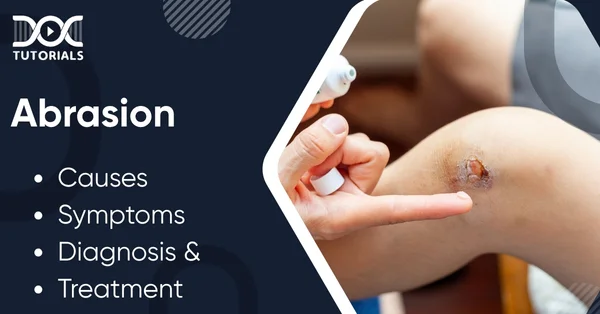Abrasion: Symptoms, Causes, Diagnosis, Treatment

An abrasion is a wound that results when the external skin is scraped off, also known as a scrape. Such an injury commonly happens due to accidents like falling from a bike or tripping on a rough surface. Abrasions commonly result in minor bleeding, skin discomfort, and discolouration in the area where the skin has been scraped.
Minor abrasions are usually managed at home by appropriate cover protection. Awareness of causes, symptoms, diagnosis, and treatment for abrasion ensures early treatment and efficient long-term management.
Additionally, if you are an aspiring medical student preparing for the NEET PG exam, learning about abrasion is crucial for expanding your knowledge base and excelling in the exam. Keep reading to learn more about abrasion.
What is an Abrasion?
An abrasion is a minor injury in which the top layer of skin is scraped off due to contact with a rough or harsh surface. It might cause slight bleeding and discomfort. Abrasions typically develop due to friction, such as when your skin is rubbed or dragged across a surface. They usually involve only the outermost layer of the skin, and it often happens unintentionally.
What are the Types of Abrasions?
There are 3 main types of abrasions:
- Linear: This is also known as a scratch, and it occurs in the form of a thin line on the skin due to contact with a sharp or pointed object, like a thorn.
- Grazed: Also referred to as a brushed abrasion, this results when your skin rubs or scrapes against a rough surface, often covering a larger area, such as a scraped knee.
- Patterned: This abrasion results from an object pressing and rubbing directly against the skin, leaving a wound that matches the object’s shape and size. For example, scratches from a cat’s nails cause wounds reflecting the shape of the claws.
What are the Causes of an Abrasion?
An abrasion is a frequent injury that can occur to anyone at any time. However, children and older adults are often prone to abrasions due to variations in motor skills and coordination compared to individuals in their middle years.
There are several causes for abrasions, including:
- Tripping or slipping onto rough areas such as sidewalks, paved roads, or play equipment at home
- Ongoing scraping or pressure that gradually breaks down the skin’s surface
- Striking hard or rough surfaces
- Road rash trauma
- Pressure or impact from rough or rugged objects
What are the Symptoms of an Abrasion?
Abrasions are of all shapes, sizes, depths, and colours. Some typical signs include:
- Bleeding that rapidly forms clots
- Swelling of the affected part
- Redness surrounding the wound
- Pain or soreness on contact
- Bruising close to the abrasion
- Abrasions are generally found on the body and head, but can also occur on the knees, elbows, arms, and legs.
What is the Diagnosis of Abrasion?
An abrasion injury is usually minor and does not require a medical professional’s diagnosis. However, medical attention may be necessary in serious accidents where the abrasions are large or deep.
A medical professional diagnoses an abrasion by examining the wound visually and confirming:
- The type of abrasion is based on its appearance
- The size and shape of the wound
- Where the abrasion is located on the body
- The degree of skin damage
- Whether any foreign material or debris remains in the wound
During a physical examination, the healthcare provider will also take the complete medical history and ask questions such as:
- When did the injury take place?
- Where did the injury occur?
- What caused the abrasion?
- Is the area painful?
These details assist the provider in recommending the most appropriate treatment based on the symptoms.
What is the Treatment for an Abrasion?
Although most scrapes are minor, there is always some risk of infection with any open skin. Proper wound care can reduce this risk. The key to home treatment of abrasions is maintaining the cleanliness of the wound, the surrounding skin, and any surface that touches or moves close to the wound.
When caring for children with abrasions, it’s helpful to soothe them and assure them that care will be provided. The following treatment steps are generally applicable for minor abrasions across all age groups:
- Hands must be washed and dried thoroughly before touching the wound
- Clean the injured area gently with soap and water or a saline solution; avoid scrubbing the skin
- Lightly pat the area with a clean washcloth or towel
- Apply a thin layer of antiseptic cream or petroleum jelly to cover and protect the wound
- Cover the bruised area with a soft, sterile pad or gauze to avoid exposing it
- Inspect the area daily under the dressing for dryness and cleanliness
- Change the dressing frequently to facilitate recovery and prevent infection
FAQs About Abrasion
- Do abrasions cause scarring?
A minor abrasion wound recovers within two weeks and hardly results in scarring. Severe or profound abrasions, particularly if infected, can cause scarring. Daily wound cleaning and dressing can avoid this effect.
- Can an abrasion result in inflammation?
Infection is the most frequent condition caused by skin abrasions. When bacteria or other foreign substances invade the wound, the body’s defence mechanism reacts, initiating inflammation and tissue injury. This process also slows down healing.
- How is abrasion caused?
Abrasion is a form of wear caused by hard particles embedded between two surfaces that roll or slide on each other. It can be two-body abrasion, where particles scrape material off directly, or three-body abrasion, where particles migrate between the surfaces.
- Does skin grow back after abrasion?
Minor scrapes and cuts recover in two weeks. The body’s inflammatory reaction begins immediately, and new skin protects the cut. However, deeper wounds, such as surgical cuts or severe injuries, may take several weeks or even months to heal fully.
- Why is my abrasion not recovering?
Several conditions, such as dead skin (necrosis) and foreign bodies, impede wound recovery. Infection is also a prevalent cause, as the body attempts to kill bacteria before closing the wound.
Conclusion
Abrasions are among the most common forms of injury, particularly in children who have yet to learn how to move safely around the environment. If a scrape is located on a large portion of the body or has any signs of infection, one should seek medical care from a doctor or an emergency centre.
Understanding abrasions—and how to manage them—is essential for every medical student preparing for the NEET PG exam. At DocTutorials, we provide video classes by expert professionals, quick revision programs (QRPs), and fun study notes. We help you clear your exams and give you skills to solve real clinical issues.
Explore our NEET PG study notes today and confidently proceed with your medical career!
Latest Blogs
-

NEET PG Exam 2025- Date, Pattern, Marking Scheme, Subject Wise Weightage, and Exam Mode
NEET PG Exam 2025 is the ultimate gateway for medical graduates aspiring to pursue postgraduate courses in medicine, including MD,…
-

INI CET Exam 2025: Your Roadmap to Success – Key Topics, Strategies, and Lessons from Last Year’s Papers
The INI CET exam is more than just a test; it’s a significant milestone for many medical students aiming to…
-

INI CET Exam Success: Previous Year Question Papers & Ultimate Guide – INI CET PYQ
One can feel overwhelmed while preparing for the INI CET (Institute of National Importance Combined Entrance Test). A vast syllabus,…




